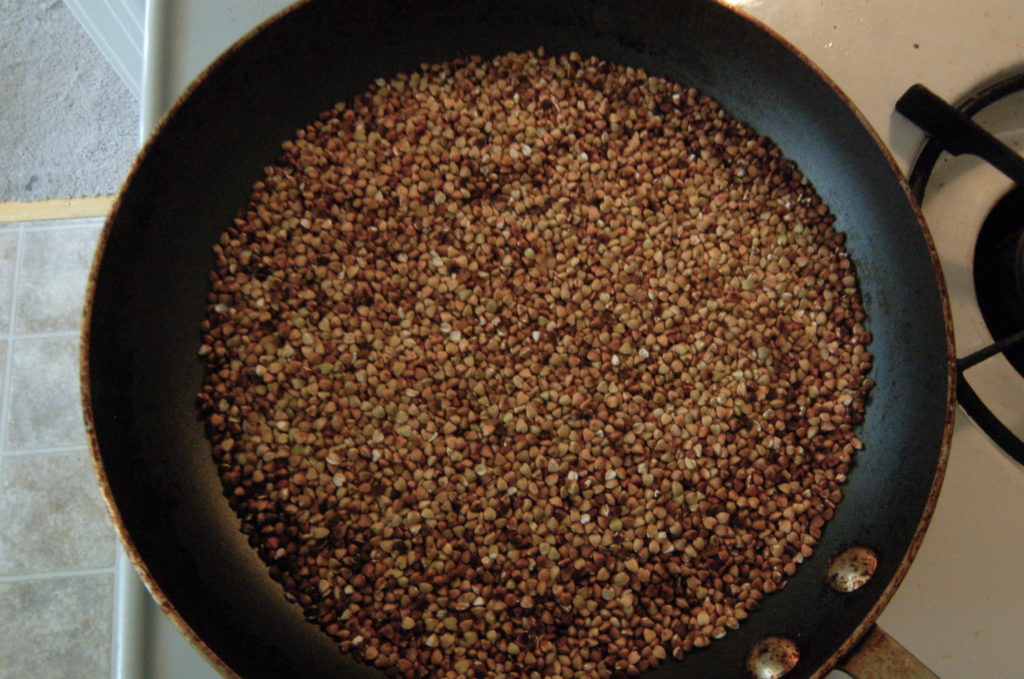So, you’re at a health food store or a place that sells foreign food or something and you see these oddly-shaped grains. They’re like little tiny pyramids. They might be labelled “buckwheat” or “kasha.” They’re probably sold toasted (but you can get them raw as well).
Don’t pass them by. These little things are GOLD. They’re like the best thing a broke college student can put in their body. They’re healthy or something, too – good for your heart and stuff. Oh, and though it’s called buckwheat, it’s more closely related to rhubarb than to wheat. It’s technically not even a grain (which is why its gluten-free).
Look, just eat some buckwheat, okay? Here are a bunch of ways to enjoy this delicious, nutritious not-actually-a-grain:
1. Enjoy it as-is
Give your buckwheat 10-15 minutes in the microwave or on the stovetop, submerged in water, make it or according to the instructions on the box. It makes a really simple, easy, late-night snack that’s healthier than all that ramen you probably consume at weird hours.
You can get buckwheat that comes in little bags to make draining easier. Just throw the buckwheat in a bowl and toss with a pat of butter or a couple of splashes of olive oil. It goes great with any condiment you might have laying around. I’ve ended up throwing everything in it: malt vinegar, hot sauce, soy sauce – seriously, anything goes with buckwheat.
2. Make it a meal
That’s just the beginning. If you want to make buckwheat into a decent meal, you have plenty of options too. You can cook it in vegetable, beef or chicken broth for extra flavor, add in bits of meat (bacon, sausage, etc.) and throw in sautéed vegetables. Veggies like kale and mushrooms work nicely as well.
3. Bake with it
Buckwheat-paprika loaves with sautéed mushrooms, anyone? If you’re looking for something gluten free, why not this buckwheat banana bread? Some recipes use whole buckwheat and some use buckwheat flour.
4. Buckwheat Blini
Looking to make something fancy? Blini (not “blinis,” blini is already plural) are thin, Russian pancakes and are made either from wheat flour or buckwheat flour. Buckwheat blini are the perfect accompaniment to cured and smoked fish or red caviar.
5. Soba
Soba, in Japanese, refers both to buckwheat itself and to noodles made from buckwheat flour. Soba noodles are often served cold with sauce, but can sometimes be served hot in a soup. It makes a great base for noodle salads.
6. Kasha Varnishkes
Buckwheat, pasta, onions and schmaltz. Need I say more? Sure, this recipe may say “rendered chicken fat or olive oil,” but Ashkenazi cuisine relies heavily on the flavor of rendered chicken fat (AKA schmaltz). So, if you want a sad parody of what this dish is supposed to be, go ahead, ruin a perfectly good meal. But if you want to make this dish properly, use the chicken fat.
7. Microgreens
Buckwheat microgreens are actually some of the easiest microgreens to grow. If you have supplies for growing microgreens (a growing tray and growing mat), you can just use buckwheat that’s available in bulk at many grocery stores (just make sure it isn’t toasted). Their reddish stems make for a sharp contrast with other salad greens and they make a nice garnish for any dish.
8. Sprouts

Photo courtesy of jaqueline on Flickr
Sprouting buckwheat is easy. You just need some untoasted buckwheat and a jar. Soak your jar of buckwheat for six hours in water, then rinse and drain twice a day for about two days. Eat them as they are, or dry them. Once dried, you can grind them into sprouted buckwheat flour in a coffee grinder or roast them and grind them to make buckwheat malt.
9. Tea
Buckwheat isn’t just for eating. Besides beer and whiskey, buckwheat has managed to make its way into tea. In Japan, soba-cha is made from buckwheat leaves and has a delicious, nutty flavor. To make your own, steep roasted buckwheat in water for four minutes.


